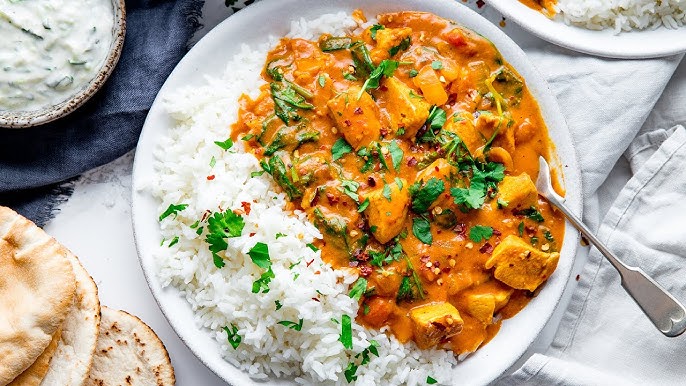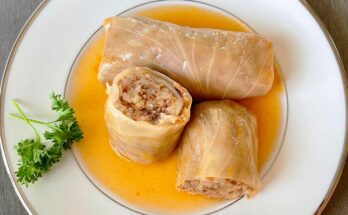Curry Chicken Recipe: Curry Chicken is a beloved dish that has found its way into kitchens around the world. A flavorful combination of tender chicken pieces simmered in a rich, aromatic curry sauce, this dish embodies the perfect blend of spices and tradition. Originating from South Asia, curry chicken has evolved, taking on unique regional flavors in countries like India, Jamaica, and Thailand.
Whether you’re a seasoned cook or trying your hand at curry for the first time, this guide will walk you through each step to create a meal that’s both comforting and bursting with flavor.
Ingredients Needed for Curry Chicken
The key to a great curry is using fresh, quality ingredients. Here’s what you’ll need:
Main Ingredients:
- 1.5 lbs (700g) chicken thighs or drumsticks (bone-in or boneless).
- 2 medium onions, finely chopped.
- 3 cloves of garlic, minced.
- 1-inch piece of ginger, grated.
- 2 medium tomatoes, diced.
- 1 cup coconut milk or chicken stock.
- 3 tablespoons curry powder or paste.
Spices and Seasonings:
- 1 teaspoon turmeric powder.
- 1 teaspoon cumin powder.
- 1 teaspoon coriander powder.
- ½ teaspoon chili powder (optional for heat).
- 2 tablespoons cooking oil or ghee.
- Salt and pepper to taste.
Optional Add-Ons:
- 1 cup diced potatoes or carrots.
- Fresh cilantro for garnish.
- A squeeze of lime juice for a zesty finish.
Essential Equipment
Cooking curry chicken doesn’t require a professional setup, but having the right tools can make the process smoother:
- A large skillet or heavy-bottomed pot for even cooking.
- A sharp knife and cutting board for ingredient preparation.
- A wooden spoon or spatula for stirring.
- Measuring spoons and cups for accurate spice ratios.
Substitutions: If you don’t have a skillet, a regular non-stick pan will work. For blending spices, a small mortar and pestle can be helpful but isn’t mandatory.
Preparing the Ingredients
Before diving into cooking, preparation is key to ensuring a seamless process.
Cleaning and Cutting the Chicken:
- Rinse the chicken thoroughly under cold water and pat it dry with paper towels.
- Cut the chicken into bite-sized pieces if using boneless cuts. For bone-in pieces, make small incisions for better flavor absorption.
Prepping the Aromatics:
- Chop onions, garlic, and ginger finely for a smooth curry base.
- Dice tomatoes or blend them into a puree for a rich texture.
Organizing the Spices:
- Measure out all your spices and keep them in a small dish or spice box. This ensures you can add them quickly during cooking.
Step-by-Step Cooking Instructions
Step 1: Marinating the Chicken
In a bowl, combine the chicken pieces with 1 tablespoon of curry powder, turmeric, salt, and a drizzle of oil. Let it marinate for 20–30 minutes. This step infuses the meat with deep flavor.
Step 2: Preparing the Curry Base
- Heat oil or ghee in your skillet over medium heat.
- Add the onions and sauté until golden brown.
- Stir in garlic and ginger, cooking until fragrant.
- Add tomatoes, cooking them down until they form a thick paste.
Step 3: Cooking the Chicken
Push the curry base to the side of the pan and add the chicken pieces. Sear them for 2–3 minutes on each side until lightly browned.
Step 4: Simmering for Rich Flavor
- Mix the chicken with the curry base and pour in the coconut milk or chicken stock. Stir well.
- Cover and let it simmer on low heat for 25–30 minutes, allowing the flavors to meld together.
Step 5: Adjusting the Seasoning
Taste the curry and adjust salt, pepper, or spices as needed. If it’s too thick, add a splash of water or stock.
Tips for Perfect Curry Chicken
Making curry chicken is an art, but even the most skilled cooks need a few tips to elevate their dish. Here are some expert suggestions to ensure your curry is flawless every time:
- Use Fresh Spices: Spices lose their potency over time. For a robust flavor, use fresh curry powder, turmeric, and other spices.
- Don’t Rush the Base: Take your time sautéing the onions, garlic, ginger, and tomatoes. A well-cooked base is the foundation of a great curry.
- Balance the Spices: If your curry tastes too strong, add a pinch of sugar, a splash of lime juice, or a dollop of yogurt to balance it out.
- Simmer for Depth: Let the curry simmer on low heat for at least 20 minutes. This allows the spices to infuse the chicken thoroughly.
- Taste Frequently: Don’t hesitate to taste your curry throughout the cooking process. Adjust the seasoning as you go to ensure a perfect final product.
Serving Suggestions
Curry chicken shines when paired with the right accompaniments. Here are a few options to serve alongside your curry:
- Rice: Steamed basmati rice is the classic choice, but jasmine or brown rice works well too.
- Bread: Warm naan, roti, or paratha are excellent for soaking up the flavorful sauce.
- Side Dishes: Serve with a simple cucumber salad or a side of roasted vegetables for added freshness.
- Condiments: Mango chutney, raita, or pickles can enhance the flavors and provide contrast.
To elevate your presentation, garnish your curry with fresh cilantro leaves and serve it in a decorative bowl. For a festive touch, sprinkle fried onions or toasted cashews on top.
Variations of Curry Chicken
Curry chicken is incredibly versatile and can be customized to suit your preferences or regional influences. Here are some popular variations:
Coconut Milk Curry: Swap the chicken stock for creamy coconut milk. This version is rich and slightly sweet, perfect for those who prefer a milder curry.
Spicy Curry: Amp up the heat by adding fresh chilies, cayenne pepper, or extra chili powder.
Regional Twists:
- Indian Style: Use garam masala and add boiled eggs for a traditional Indian twist.
- Jamaican Style: Include allspice, thyme, and Scotch bonnet peppers for an island-inspired kick.
- Thai Style: Use Thai red or green curry paste and add vegetables like bamboo shoots or bell peppers.
Storing and Reheating Curry Chicken
Leftovers? Lucky you! Curry chicken often tastes even better the next day. Here’s how to store and reheat it properly:
- Storing: Let the curry cool completely before transferring it to an airtight container. Store it in the refrigerator for up to 3 days or freeze it for up to 3 months.
- Reheating: For best results, reheat curry on the stovetop over low heat. Add a splash of water or stock to loosen the sauce. Microwave in short intervals, stirring in between, if you’re in a rush.
Pro Tip: Curry tends to thicken when stored. Adding liquid during reheating restores the original consistency.
Health Benefits of Curry Chicken
Curry chicken isn’t just delicious—it’s also packed with nutritional benefits:
- Protein: Chicken is an excellent source of lean protein, essential for muscle repair and growth.
- Anti-Inflammatory Properties: Spices like turmeric and ginger have anti-inflammatory and antioxidant properties.
- Vitamins and Minerals: Ingredients like tomatoes and onions provide vitamins C and B6, while coconut milk is a source of healthy fats.
- Customizable for Health: For a lighter option, use skinless chicken breasts and substitute coconut milk with low-fat yogurt or almond milk.
Alternative Protein Options
If chicken isn’t your preference, try these protein alternatives for your curry:
- Tofu: For a vegetarian option, use firm tofu. Sear it before adding to the curry for better texture.
- Shrimp: Cook shrimp for a few minutes towards the end to prevent them from becoming rubbery.
- Lamb or Beef: Adjust the cooking time for tougher meats, simmering them longer to ensure tenderness.
- Paneer: A classic Indian option, paneer absorbs the flavors beautifully while adding a creamy texture.
Curry Chicken for Special Occasions
Looking to impress guests at a dinner party? Curry chicken is a great choice. Scale up the recipe and serve it family-style with a variety of sides. For an extra-special touch, garnish with edible flowers, toasted nuts, or a drizzle of saffron-infused cream. Pair it with sparkling water or a light red wine to complete the meal.
Homemade Spice Mix vs. Store-Bought
Homemade spice blends allow you to control the flavor and freshness of your curry. Here’s a simple recipe for a DIY curry powder:
- 2 tablespoons ground coriander
- 1 tablespoon ground cumin
- 1 tablespoon turmeric
- 1 teaspoon ground ginger
- ½ teaspoon chili powder (optional)
While store-bought options are convenient, they often lack the depth of freshly ground spices. If you go for store-bought, look for high-quality brands with minimal additives.
FAQs about Curry Chicken Recipe
What is curry chicken?
Curry chicken is a flavorful dish made by cooking chicken in a spiced curry sauce. It is popular in many cuisines, including Indian, Jamaican, and Thai, with variations in spices and ingredients.
What ingredients are needed for curry chicken?
The basic ingredients include chicken, curry powder or paste, onions, garlic, ginger, tomatoes, and coconut milk or yogurt. Additional spices like turmeric, cumin, and coriander may be used, depending on the recipe.
How long does it take to cook curry chicken?
Curry chicken typically takes about 30–45 minutes to cook, depending on the cut of chicken and the cooking method used.
Can curry chicken be made spicy?
Yes! You can adjust the spiciness by adding chili peppers, cayenne pepper, or hot curry powder to the recipe.
What can I serve with curry chicken?
Curry chicken pairs well with steamed rice, naan bread, roti, or even a side of fresh salad.
Can I use boneless chicken for curry?
Absolutely! Both boneless and bone-in chicken work well, but bone-in chicken adds more flavor to the dish.
How do I store leftover curry chicken?
Store leftover curry chicken in an airtight container in the refrigerator for up to 3–4 days. For longer storage, freeze it for up to 3 months.
Can I make curry chicken in advance?
Yes, curry chicken often tastes better the next day as the flavors deepen. Simply reheat it on the stove or in the microwave before serving.
Final Thoughts
Making curry chicken is an enjoyable and rewarding experience. This recipe provides a base for endless creativity, allowing you to tailor it to your taste and preferences. Whether you’re cooking for yourself or a crowd, curry chicken is sure to please.



